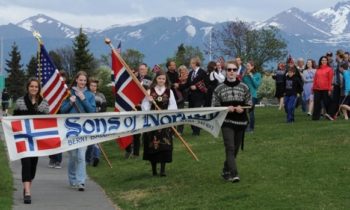 Wherever Kare Aas travels, be it in far-north territory like Alaska or places well to the south, he seems to get one persistent question: Why are Norwegians so happy?
Wherever Kare Aas travels, be it in far-north territory like Alaska or places well to the south, he seems to get one persistent question: Why are Norwegians so happy?
Aas, Norway’s ambassador to the United States, said he often shares Norwegian perspectives and experiences, but he does not suggest they be adopted by others.
“I think people are interested in what Norway has achieved,” Aas said in an interview during a week-long visit to Alaska. “That is something different than asking for advice.”
“It’s up for each country, each state to decide its policies,” he said.
What Norway has achieved, along with consistently high rankings for quality of life, is status as one of the world’s top petroleum producers, even as it moves away from use of fossil fuels at home; a diversified economy that helps insulate it from shocks in prices for oil and other commodities; and social and infrastructure investment intended to benefit all its citizens.
As Aas described it during the interview and in a speech on Monday to the Anchorage Chamber of Commerce, a balanced approach to oil and gas development is one reason for Norway’s success.
Norway is Europe’s biggest producer of petroleum liquids and the world’s third-largest natural gas exporter, according to a report by the U.S. Energy Information Administration.
The oil and gas sector provides 15 percent of Norway’s gross domestic product, 20 percent of Norway’s state revenues and 39 percent of the nation’s exports, Aas said in his chamber speech. Revenues have been used to build a sovereign wealth fund now worth $800 billion, of which a small amount — no more than 4 percent of annual earnings — is available for government spending. In contrast, the Alaska Permanent Fund, Alaska’s sovereign wealth fund, is worth about $52.7 billion; roughly half of annual earnings are distributed in dividends and none of the money is used to pay for government operations.
Norwegian officials understand that the nation’s oil and gas production, all from offshore sites, will ultimately end, Aas said. Still, that day is decades into the future, and Norway for now will continue to search for more oil and gas reserves and continue moving its frontier north into the Barents Sea, he said.
“It’s not an end to the oil and gas era but it may be slowing down,” he said.
The Norwegian government also recognizes the drawbacks to oil and gas production and works to mitigate them, Aas said. For example, some areas have been put off-limits to oil development to protect fisheries and indigenous interests, he said.
On a broader scale, the Norwegian government is committed to combating the climate-change effects of fossil fuels, he said. Norway was one of the first nations to join the Paris climate agreement, the 2015 accord to reduce greenhouse gases and hold global warming to less than 2 degrees Celsius over pre-industrial levels. Norway is already using renewables — largely hydropower — for virtually all of its internal power generation, he said. Norwegians’ fuel consumption is curbed by very high taxes on gasoline and by a tax that effectively doubles the purchase price of vehicles, he said. Electric-powered vehicles are very popular in Norway, he added.
A second pillar, as Aas explained it, is Norway’s commitment to equality.
Everyone, no matter where they live in Norway, is entitled to the same quality of infrastructure, social support and opportunity, he said. That philosophy is paying off in northernmost Norway. Only 10 percent of the national population lives north of the Arctic Circle but the region is thriving, thanks to a diversified economy with interests in tourism, fishing, marine and land transportation, health care and education, notably the University of Tromsø-The Arctic University of Norway. The government has placed a high priority on science and research, Aas said.
“They see and they understand that by the end of the oil age, it’s important for Norway and the Norwegians to have another basis for the society,” he said.
A third source of success for Norway, as Aas described it, is engagement with the outside world.
Norway has long been active in pan-Arctic affairs, and now there is keen interest from countries far to the south in the Arctic and Norway’s role in it, he said. A “clear signal” of southern interest in the Arctic, he said, is the large number of nations and organizations vying to win designation as official observers in the 20-year-old, eight-nation Arctic Council.
He cites climate change as a main catalyst but said it is not the only one. Oceans and fisheries, environmental concerns and oil and gas development also link the Arctic to the south, he said.
“What happens in the Arctic does not remain in the Arctic,” he said.
On the local and regional levels, Norway continues to engage with Russia, even as broader geopolitical tensions mount over Russia’s actions in Ukraine. Norway no longer conducts joint military exercises with Russia, but the two countries are cooperating on mutual border interests like search-and-rescue readiness, environmental cleanup and fisheries management, Aas said. People-to-people exchanges continue across the border, despite the bigger disputes between Russia and other governments. That is a longstanding tradition, he said.
“The people have been in contact for generations,” he said.
The Alaska trip is, in a way, a similar people-to-people exchange. Aas has met with business and government leaders, marched Tuesday in a Norwegian Constitutional Day parade in Anchorage and was headed to the small southeast Alaska town of Petersburg, known for its Norwegian ties, to take part in the annual Little Norway festival held there.
(adn)
